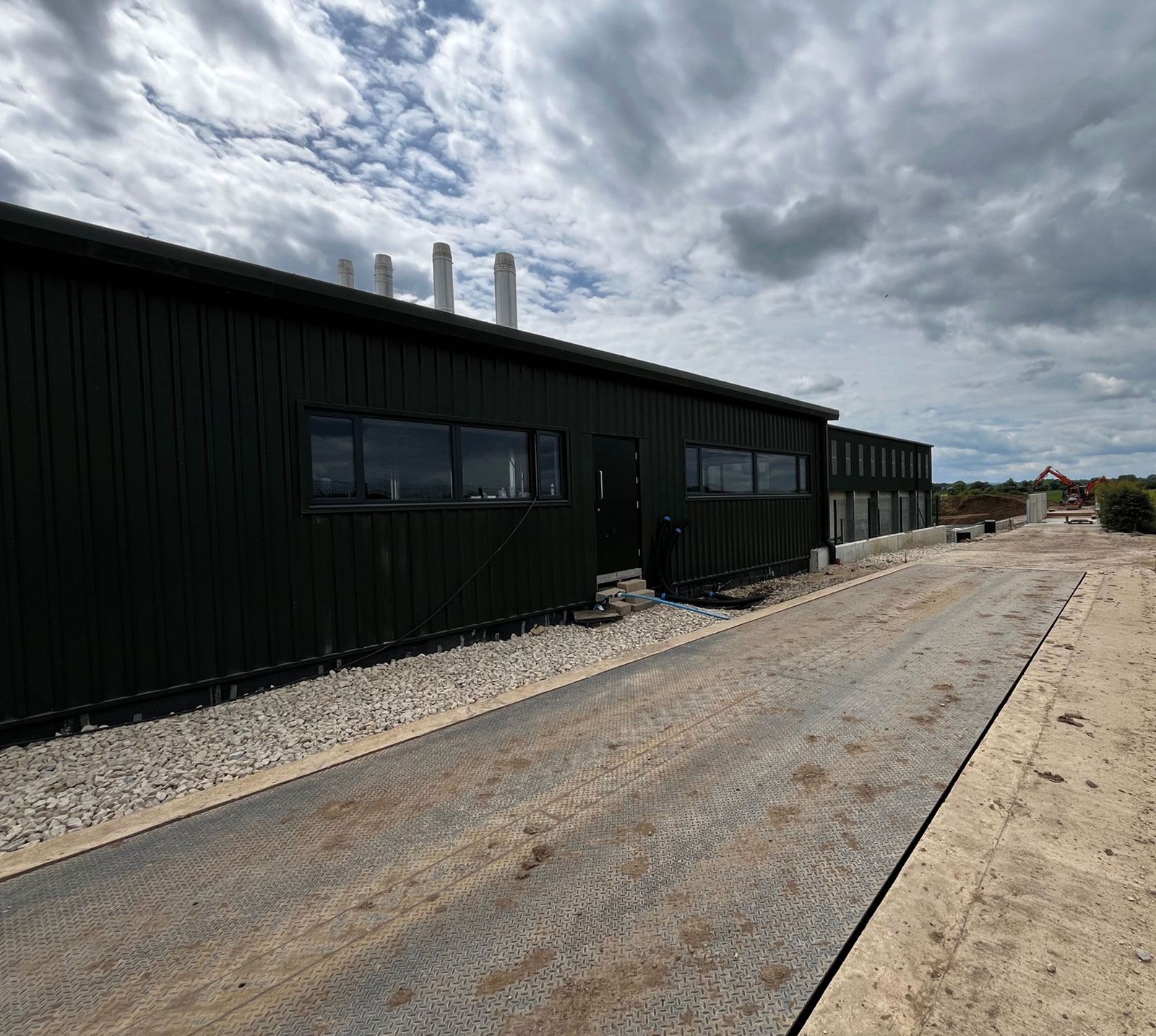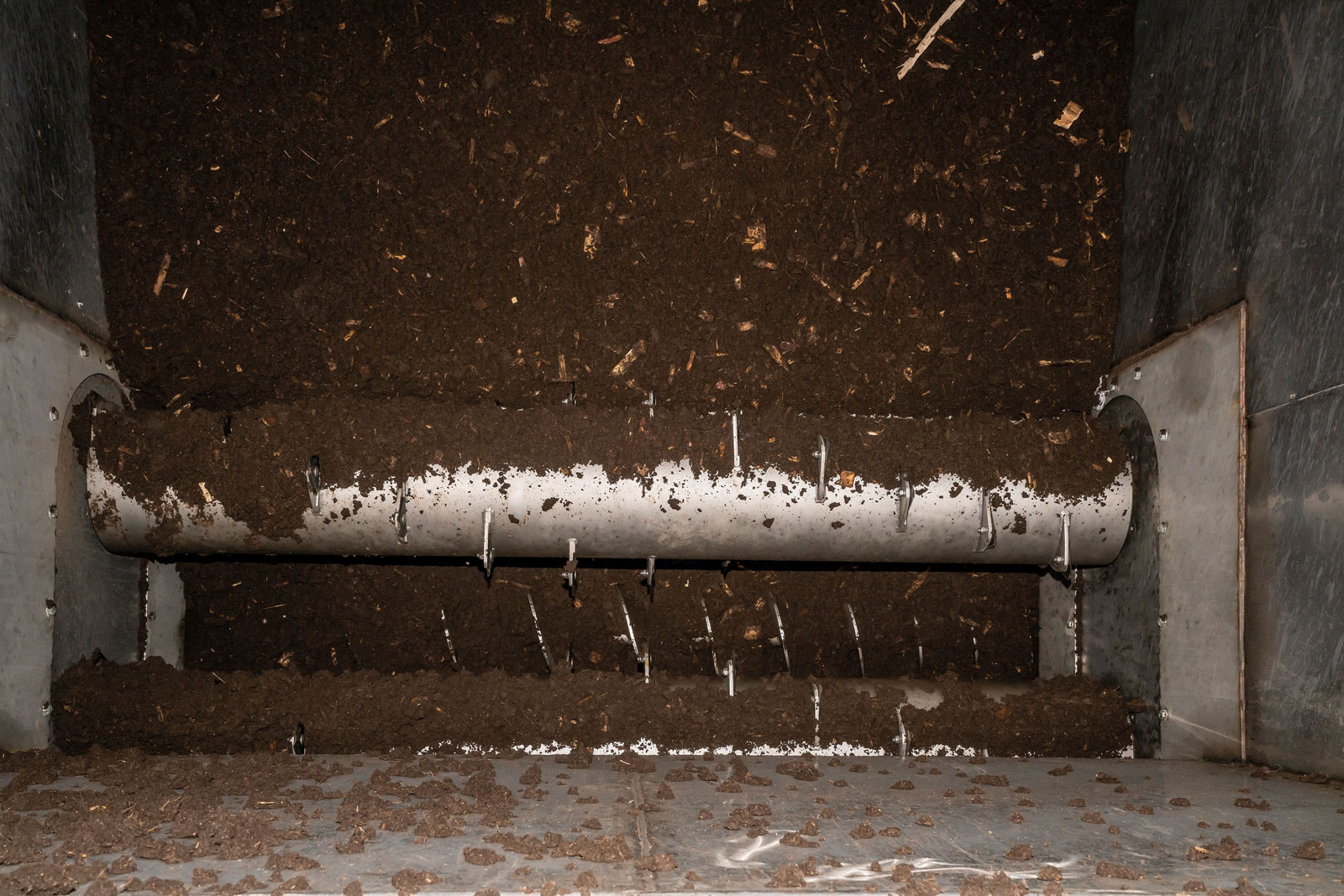Newquip composting technology offers novel manure processing option
Published on : 1 Jul 2024

Biomass boilers fueled on woodchip supplement the heat necessary to reduce moisture content to just 5%
The majority of farmers apply their muck to land. The combination of Nitrate Vulnerable Zone (NVZ) spreading restrictions and mounting publicity of the concerns of nutrient imbalance and potential for environmental harm caused directly or indirectly by the poultry industry is driving the industry to investigate, and now invest, in methods to process manure. Together with one pioneering farmer, Newquip, the UK distributor for Big Dutchman equipment, has designed a system of processes to produce a high quality fertiliser from raw poultry manure. Pre-existing machinery is arranged in a unique layout with the ambition to optimise both the nutrient value of the finished product, but also the environmental credentials of the operation itself. Ranger visited the farmer to learn more. It’s a sad indictment of today’s world that our coverage is only on the basis of anonymity, so for the purposes of this article, we’ll refer to our producer as Peter.
On entry to the site, after wheel wash and spray barrier, vehicles will travel over a weighbridge
On the face of it, Peter’s business has the perfect circular farming story. The hens’ muck is stored ready for application to land at the appropriate moment, quickly incorporated into the soil to help the next cereal crops to perform. Conscious of the diminishing capacity for soil indices to continually accommodate muck, Peter was keen to find a way to add value to the potent raw material by improving the consistency and reducing moisture content. “Muck in August, when the house ventilation is working hard, is very different to muck produced in December. And while we can use a lot of manure on the land in a short period of time after harvest, for the rest of the year, we have to store large quantities which brings its own headaches. Our dry matter is pretty good, at around 37 to 40%, and our muck store capable of holding a full years’ production, but for a long time now, I’ve wanted to find a better way, ” said Peter.

A cross conveying auger removes the finished compost
Nearly 2% of global energy is used for the production of ammonia fertiliser, 88% of which is consumed within agriculture. In manure, we have an incredibly valuable source of plant nutrient at our fingertips, we just need to establish ways to harness it. The aims of this farm trial are to convert manure from a useful byproduct for those with access to sufficient land and crop demand, to a consistent and high quality alternative to conventional chemicals. But the potential goes much further. With many producers reliant on field heaps and 3rd party soils, arrangements which appear to be on borrowed time, proof of this concept may open the way for a network of co-operative investments into not just waste management, but value creation. Adam Dye, managing director of Newquip says, “The finished product should match all of the benefits of using chemical fertiliser. Crucially, it must be consistent and stable so that application to land can be made accurately. It needs to be readily transportable and storable, odourless and inert.”Arriving at the site, the ambition of the project is plain to see, even with the build far from complete. The building is comparable in size to a large poultry shed, some 120 metres in length with higher elevations providing a 4 metre drop from raw material intake to finished goods dispatch, plus the all-important airspace to create a plenum – an aerobic chamber where the composting will happen. Commissioning is expected in late 2024, and the contractors are currently mid-way through the building phase. The unit itself is deliberately sized, Peter having taken guidance on animal byproduct and waste management legislation to hit a sweet spot in scale versus bureaucracy. Capacity for this trial is anticipated to accommodate around half a million layers’ manure, but Adam stresses that this is a scalable enterprise. “This concept is entirely scalable with potential to aid existing farms by adding value to manure. It’s relevant to any future farmers, providing a solution for planning legislation whilst improving arable soils organic matter with associated benefits and reducing emissions from agriculture.”The capacity necessitates purchasing raw manure from local farms, but with an ambition to produce a premium finished fertiliser, the specification of muck on arrival will need to be managed. For a start, only manure from belts will be accepted, minimising foreign objects and increasing consistency. Biosecurity measures upon arrival include a large wheel wash and curtain spray system, with accompanying filtration and storage tanks. Vehicles then tip to a hopper, crossing over a weighbridge on the way in and out. Manure is then blended with a biomass, providing structure, improving stability and feeding the all-important microbials. The mixture is deposited on long, elevated platforms and the process of aeration begins. Over a fortnight, the mixture is dried, oxygenated and continually agitated by robotic cultivators in the plenum. The temperature target is around 65 degrees, sanitising the mixture of pathogens but protecting the microbes. The end result is a compost with around 80% organic dry matter. At this point, further moisture is removed in the pelletising process with a targeted 95% dry matter content, ready for storing and shipping. Heavy investment in environmental protectionThe green credentials of the project itself go above and beyond. Features include ammonia scrubbing, heat recovery and recirculation, rain water harvesting and wash water recycling. 800kw of biomass boilers are used to top up the recovered heat needed for drying raw material, improving consistency, or pelletising the finished product. 500 kW of roof mounted solar panels cater for the majority of the electrical load. As with air scrubbers, now commonplace on extensions and new farms, sulphuric acid is a byproduct. Extensive critical control measures including bunding, specialist piping, limited and secure access, isolation and monitoring mechanisms are in place. Potash is used to neutralise surplus acidity, reducing the carbon dioxide emissions of alternatives such as pig slurry or sodium bicarbonate, and creating a secondary valuable output for fertiliser. Through the mitigation of traditional soil conditioners and the emissions associated with spreading the raw muck, calculations suggest the process will offset the carbon dioxide emissions equivalent to several million trees annually. Peter and Newquip have enlisted the support of academic research and development, evaluating their ambitious hypotheses. Results from a study by Teesside University are eagerly anticipated, due later in the summer. The hope is that findings validate the efficacy as a fertiliser, and help better understand the symbiotic microbial relationships between nutrient and beneficiaries. Scientific results will help break down the barriers to use in arable farming. If the best day to solve the manure conundrum was decades ago, but the second best day is today, arguably, the timing couldn’t be better. With soil-based agriculture under the same spotlight as livestock farming to improve their carbon footprint and mitigate any environmental detriment, an alternative to synthetic fertilisers must be attractive to the sector. Contact has been made with several industries; fresh produce, premium horticulture, top fruit, mushroom and viticulture firms are already interested, and awareness through agronomists and farm advisors is being built.In total, it’s estimated that the spend for the entire project could nudge £5 million, equivalent to £10 for each bird placement supplying muck. Contextualised against the cost of a greenfield new build, that’s a big number. A risk, even. It’s a bold investment that should pay back through the eradication of a growing liability and the creation of a new market. Financial estimates are worked on paying farmers a fair price for belt muck, and selling the finished goods at an equivalent price per nutrient unit to conventional fertiliser. There will be no shortage of farmers reading this, questioning the scale of spend. A sledgehammer to crack a nut. Why not just dry and pelletise the stuff without all of the other processes? But that belies the real ambition here. It’s not to better manage one farms’ muck, it’s to create a new market for a product that can be used as a genuine chemical substitute in precision agriculture. To achieve that goal against such established competition, every bell and whistle, every feature and benefit, every piece of supporting evidence and advice is necessary. The UK uses an extraordinary volume of chemical fertiliser. Some 1.45 million tons annually. It’s expensive stuff, hence the popularity of chicken muck. And yet, with all that requirement, that demand, the poultry industry currently stands accused of saturating soils and allowing nutrients to leach into watercourse. Because when we apply raw manure to land, we’re doing so crudely and inefficiently without knowledge of what nutrients are being spread. Even when incorporated into the soil immediately after removal from the shed, at least 10% of the nitrogen is lost to the atmosphere. With storage, this loss can increase to between 40% and 60%. In Peter’s scenario, by taking the muck directly from the belts and immediately into the contained process, it’s hoped that around 98% of the nitrogen will be retained. The annual output of Peter’s unit is expected to be in the region of 8000 tons. Even if all layers muck were processed in this way, the resultant tonnage would be a drop in the ocean. And that’s a good thing. As with anything genuinely innovative, limitation on supply can command great interest, a premium place in the market and a commensurate price. It’ll be fascinating to watch this visionary project progress. It deserves to succeed on courage alone.
